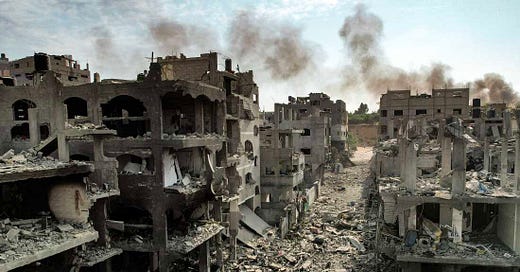The war in Gaza has reached a pivotal juncture. Israel’s strategic objectives are maximalist: to destroy Hamas’s military capabilities, to end its rule in Gaza, and to secure the return of all hostages. After 21 months of conflict, these goals have only been partially fulfilled. Hamas is weakened but not eradicated, hostages remain captive, and Gaza is devastated.
Back in October 2023, when the IDF were relatively tight-lipped and political rhetoric was running controversially high, I took a stab at divining Israeli strategy:
Whilst the first half of the above is pretty much bang on the money, what was perhaps not fully appreciated at the outset (and probably should have been) was that Hamas’s administrative function, its ability to run schools, courts, aid distribution networks, and local policing, was as central to its power as its rockets and tunnel systems. This “civilian” wing of Hamas enabled it to control the population, resist rivals, and entrench itself deeply into Gazan society. While the IDF degraded Hamas’s military capability to a point well beyond where most conventional forces would be deemed combat ineffective, the administrative networks remained intact longer, continuing to enforce loyalty, ration aid, and police communities until mechanisms like the Gaza Humanitarian Foundation (GHF) disrupted that grip.
Here is what the IDF was briefing in July 2024, which again makes no real mention of Hamas’s administrative function, other than finding an “alternative”:
It is plain that complete occupation was not on the cards at this point. The Trump administration has fundamentally changed the dynamics of Israeli strategy. It is now significantly more comprehensive than the standard punitive military operation the IDF were briefing a year ago. With White House approval, the military strategy has shifted from limited to maximalist. As a side note, conventional wisdom suggests that it is unwise to change strategic goals mid-way through a war.
Operation Gideon’s Chariots is now a campaign aimed not only at preventing future 7th October-style attacks, but also at eliminating Hamas as a functioning authority in Gaza. This shift in scope, from deterrence and battlefield dominance to total political displacement, clarifies both the campaign’s ongoing duration and the scale of destruction that has accompanied it.
The question now is: what comes next?
The fact remains, indivisible, that there is a hard limit to what can be achieved by military force alone, and Israel’s maximalist goals are unlikely to be achieved solely by that force. Three paths are possible: 1) continue the war to its bitter end, 2) declare a unilateral victory and cease hostilities, or 3) negotiate a ceasefire. I shall now examine the military, diplomatic, and economic consequences of each scenario and explore why declaring victory or accepting a ceasefire may serve Israel better than prolonging the conflict.





